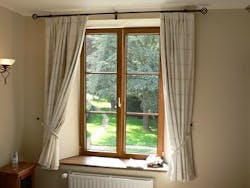Low-cost ‘smart window’ coating switches quickly from clear to opaque
Gyeonggi-do, Korea--A new type of smart window based on so-called "counterions" switches from 0% to 90.9% optical transmittance in a few seconds.1 The technology promises low cost and nontoxic manufacture, but has stiff competition from established smart-window technologies such as SmartGlass by Research Frontiers (Woodbury, NY). Smart windows can control light passing into a building or vehicle, making window-gazing more comfortable and, in some cases, saving energy.
Dip and dip again
Developed by researchers at the Korea Electronics Technology Institute, the new window is fabricated by spray-casting a kind of polymer called poly[2-(methacryloyloxy)ethyltrimethylammonium chloride-co-3-(trimethoxysilyl)propyl methacrylate] on glass. If the glass is dipped in a solution containing thiocyanate (SCN-) ions, it quickly becomes transparent; dipping the glass in a solution with bis(trifluoromethane)sulfonimide (TFSI-) ions quickly turns the coating opaque by forming microporous scattering structures. The cycle can be repeated many times. (By the way, the term "counterion" might be easier for some people to understand if it were spelled "counter-ion.")
Smart windows that block sunlight from entering buildings in summer and switch back to full transparency in winter already are available; however, some of the technologies have drawbacks such as high cost, rapid deterioration in performance, and manufacturing processes that involve potentially toxic substances, which the new window doesn't have.
However, the researchers will have to work out a way to switch the windows that doesn't involve dipping them in different solutions.
REFERENCE:
1. Chang Hwan Lee et al., ACS Nano, 5 Aug. 2011, DOI: 10.1021/nn202328y.

John Wallace | Senior Technical Editor (1998-2022)
John Wallace was with Laser Focus World for nearly 25 years, retiring in late June 2022. He obtained a bachelor's degree in mechanical engineering and physics at Rutgers University and a master's in optical engineering at the University of Rochester. Before becoming an editor, John worked as an engineer at RCA, Exxon, Eastman Kodak, and GCA Corporation.
